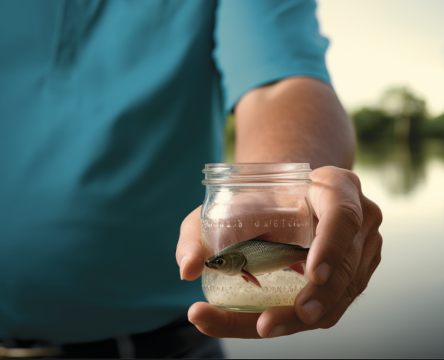Micro Fishing is the Ultimate Adventure
Exploring the World’s Smallest Catches with Ultralight Tackle
Micro fishing is more than just an alternative to traditional angling—it is a pursuit that transforms the way we experience water, nature, and the thrill of the catch. It offers a window into an often-overlooked world, where the smallest fish become the most challenging adversaries. From the hidden streams of North America to the storied waters of Japan, micro fishing is gaining a devoted following among those who seek adventure in the most unexpected places.
In this feature, we explore what makes micro fishing an exhilarating pursuit, the essential gear required for success, and how anglers worldwide are embracing the sport as a way to connect with nature on a deeper level.
A Different Kind of Fishing Experience
For many anglers, the allure of fishing is in the pursuit of trophy-sized catches—large bass, powerful pike, or deep-sea behemoths. Micro fishing turns that mindset on its head. Instead of the biggest fish, anglers seek out the smallest, often species that grow no longer than a few inches. These fish, often dismissed as mere baitfish in conventional fishing, are the true stars of the micro fishing world.
Micro fishing is not defined by the size of the fish alone but by the experience. It is a methodical, precise, and deeply immersive practice. Anglers crouch by the water’s edge, peering into the shallows to spot their quarry. They use tackle so fine and delicate that even the slightest movement transmits through the line like an electric current. Unlike traditional fishing, where the angler often waits for the fish to come to them, micro fishing is an active hunt—one that requires stealth, patience, and an understanding of fish behavior.
The Origins and Evolution of Micro Fishing
While the pursuit of small fish has existed in various cultures for centuries, modern micro fishing finds its strongest roots in Japan. Tanago fishing, a highly refined and specialized form of angling, is centered around catching species of bitterling known as tanago. The Japanese have perfected micro fishing gear, producing some of the smallest hooks and lightest lines available.
In recent years, the popularity of micro fishing has expanded far beyond Japan. Anglers in North America, Europe, and beyond have embraced the challenge of catching their native micro species. The growth of the sport has been fueled by a combination of factors: the accessibility of gear, the rise of catch-and-release conservation, and the pure joy of discovery that comes with catching a species no one else has ever caught on a hook and line.
The Gear That Makes It Possible
Unlike big-game fishing, micro fishing does not require a heavy investment in expensive tackle. A simple, well-thought-out setup is all that’s needed.
Rods for Precision
The best rods for micro fishing are lightweight and sensitive. Telescopic rods, which collapse for easy transport, are the preferred choice. These rods allow anglers to precisely drop their bait into tight spots, such as between submerged rocks or under overhanging vegetation.
Hooks: The Smaller, the Better
Standard fishing hooks are far too large for micro fishing. The most effective hooks are #30 pre-snelled micro hooks, designed to hold the tiniest bait while being virtually invisible to the fish. These hooks, like those found in the Micro Master Fishing Hook Set, are pre-tied to fine leader lines, making rigging easy.
Lines and Floats for Ultra-Finesse Fishing
Micro fishing lines are exceptionally thin, often 1- to 2-pound test monofilament or fluorocarbon. In clear water, an ultralight line makes all the difference in whether a wary micro fish takes the bait. Small self-threading floats help suspend the bait at the perfect depth.
➡️ Get Micro Fishing Floats – 20 Pack
Bait Selection
Micro fishing bait is simple yet effective. Small pieces of earthworms, dough baits, or tiny insect larvae work well. Some micro anglers use hand-rolled dough bait pellets, which mimic the small food sources naturally found in the environment.
The Best Micro Fishing Rigs for Every Scenario
There is no single “best” rig for micro fishing; different situations call for different setups. Here are four of the most effective micro fishing rigs:
The Hand Line Rig
A simple mainline-to-hook setup with no added weight, allowing the bait to drift naturally. Perfect for sight-fishing in clear, shallow water.
The Split Shot Rig
A small split shot weight placed four to six inches above the hook mimics a miniature Carolina rig. This setup works well in streams with light current, keeping the bait near the bottom while allowing it to move naturally.
The Dropper Loop Rig
By placing a snelled hook on a dropper loop above a small weight, this rig suspends the bait just above the bottom, making it ideal for catching bottom-feeders like darters and madtoms.
➡️ 4X Micro Fishing Tippet – Perfect for These Rigs
The Adventure is in the Details
For those seeking a new fishing challenge, micro fishing offers an experience unlike any other. The adventure lies not in the size of the catch, but in the pursuit itself—the careful placement of the hook, the patience required to outwit a fish no longer than a few inches, and the thrill of discovering species rarely seen up close.
Whether standing knee-deep in a mountain stream or dropping a tiny baited hook into an urban canal, micro fishing has the power to turn the ordinary into the extraordinary. In a world where the biggest catches often make the headlines, this is a sport that proves that sometimes, the smallest fish make the biggest impact.






